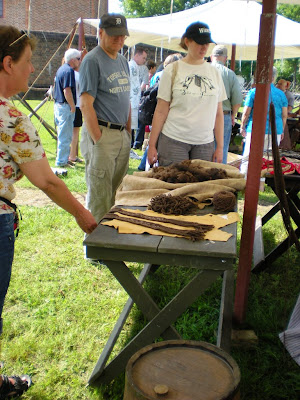The Mariner's Museum and USS Monitor Center are connected, and for one price you get both experiences. I spent the majority of my time in the USS Monitor Center, and did a backwards worn out (as in tired) tour of the Mariner's Museum.
The USS Monitor Center is the home of the Ironclad ship that fought in the Civil War. It sank, due to weather problems - a horrible storm off the coast of North Carolina's Outer Banks, on Dec 31st 1862. Located just off the southeast of Cape Hatteras, the wreck site, where the majority of the ship still lies, was the first marine sanctuary in the United States. In 1978 exploration began to find the ship, and in 1998 the propeller was pulled from the water.
The propeller on display.
In 2001, the Sanctuary and the Navy brought up the steam engine, which I did not see at the exhibit. And then, in 2002, just as funding started to run out (days left) the huge turret was found - a revolving gun turret - was discovered, along with the remains of two soldiers, and two of the cannons. A conservation building was built specifically for the conservation of the turret and other objects found. The bodies of the two soldiers are in Hawaii, not sure why...awaiting identification.
They have a great exhibit though. Despite the age and legend of the Mariner's Museum (which could go under some much needed updates) the USS Monitor Center is full of technology that is often seen in contemporary museums.


The entrance to Ironclad Revolution at the USS Monitor Center.
When you enter you go through a series of films, leading you room to room, which discuss the documentation and the experience that took place on the Monitor the night of it's sinking. It's a powerful and stimulating film that incorporates the entire environment of the small theater room. It turns out the last thing seen of the ship, after most of the crew was saved, was the lantern - a red lantern light that kept flashing, flashing..and flashing, until it finally disappeared. After you watch a video of the finding of the turret, cannons, and lantern (very touching!!) you step into a room where the lantern is displayed. The display is like the Hope Diamond. It's just the lantern, which underwent a remarkable conservation practice. I wish the picture was better, but I didn't want to use a flash..

The lantern of the USS Monitor
After you see the lantern, you are led through a variety of exhibits discussing the history of ship armory and weaponry, with interactive HD tv's featuring actors posing as historical figures, a computer game that was virtually impossible to play, and really amazing miniature ships. People spent a lot of time in here, there was a lot to learn, and it was quite interesting.
The next area discusses the atmosphere pre-Civil War and what led up to the War itself. You hear quotes from individuals like Frederick Douglass, Abraham Lincoln, Jefferson Davis, various military officials as well. It was semi interesting, but, I spent little time in this area for I knew the basics. The next spot discussed the lead up to the building of the ironclads, which was also slightly interesting, but not enough to make me want to stay in the large room made out to seem like an important officials meeting room - there were paintings, high end objects owned by regional military personnel of the period, etc.
Next we learned about the building of the ship, and what went into it, and the competition between the North and South to create these ironclad ships. It was interesting, and the room that discussed it featured a replica of the Monitor, which you could walk into, etc. After exploring this, they then had built a replica of the quarters for the soldiers and officials who lived on the Monitor. The housing was beautiful, for it's small cramped quarters - silks, white wash, silver decorations, candlelight - all meant to feel at home. I learned about the food that was served, that their chef was African American, that a lot of cured beef and ham was served, and that everyone knew every one's business - cramped quarters, if you will. They showed tons of objects that were discovered at the site - silverware with the names of fallen heroes who sank with the ship, wine bottles, glasses, and personal goods.
Then, they discussed the end of the war, freedom of slaves (in light) and such. And then they had a large display area that featured a remake of the huge turret - which was amazing, and they had reconstructed how the turret looked when they found it in the ocean - shells and barnacles, etc. You could walk into it, and it was well done - they even showed what objects were found there, based on photographs, and two casted skeletons showing the placement of the men who died in the turret.
This area also discussed the weaponry, the power of the turret, etc. A hallway lead you to the conservation building, which was built specifically to house the turret, cannons, and some other objects. The turret and cannons are currently undergoing a chemical destabilization (?) process that will make it possible to do conservation work on these important pieces in the future. Special tanks were built. The turret tank was too big to be photographed. But, here is a photo of one of the cannons in it's custom tank. Wires exposed on top help to monitor (no pun intended) the chemical levels, temperatures, etc. This is a working conservation lab, 9-5, Monday through Friday, and they also have billboards and posters discussing what is going on in the lab "this week" and such...it was VERY cool!!

I always get excited about this stuff, being a lover of transparency. It'll be very cool to go back and see what takes place after the objects are ready to be removed from their tanks.
The USS Monitor Center is very cool, and well worth it. I explored for about 1 1/2 hours. Lots of reading, and some interactive stuff that kids might think is cool. Great for even people who aren't big military history buffs - it's fascinating, slightly creepy, and very cool. There are also plenty of videos that are shown, I only saw the introduction one.
It's part of the Mariner's Museum, which is a must see for lovers of nautical history, war history, etc. The museum features exhibits on Chesapeake Bay nautical history, cartography, miniature ships, military naval history, a ship building shop (it was closed that day), a miniature building shop (closed that day) and a really great exhibit about small boats.
I put a ton of energy into my experience at the Monitor, which probably contributed to my struggle for attention at the Mariner's Museum area. I explored it backwards too, which I wish I wouldn't have. They don't do a great job at guiding the visitor, and since it's a chronological exhibit, it serves best to explore it the right way.
I started out at the rotating exhibit featuring a painter from the early 20th century who painted the ship building experiences of builders in Norfolk. There isn't anything on the website, and I didn't write his name down, which really stinks - it was amazing. Regardless, I wish I would have taken notes! Boo!!
The miniature ships were so cool, and they have an exhibition featuring the miniature ships of August Crabtree. The ships are displayed like jewels, each in its own display case. Veterans play the roles of docents in much of the museum, and a docent was on hand to discuss the history and process of ship building.
They have a small Titanic display, where you can see some artifacts from the tragic ship, and put on a life jacket and sit in a replica Titanic life boat. Then you explore the history of the naval world - from torpedo's (they have an awesome interactive with a torpedo hitting a Japanese ship) to submarines, and all the way back into history. The father back it goes into history (the beginning of the exhibit) the more jumbled and chaotic the displays are - tons of labels, images, and objects, but not enough concentration on the content. It's overwhelming. They discuss cartography in a confusing manner, and feature so many objects - including slave shackles from a slave ship, Native artifacts from the first whites to explore the continent, and more.
This area needs major renovation, but, they have a ton of remarkable objects, and the mini ships are so cool!

A small sea glass exhibit featured glass pieces from ship related culture. This was a sea glass window. Note the Prophet and Tukoseemalta. Bizarre!
The final part of the museum (not including the gift shop of course) is a fairly extensive exhibit on ship history in the Chesapeake. They start with the first peoples - Native people - and how they explored and created vessels. Then onto explorers, settlers, onto fishermen, oyster shucking culture, buoys (surprisingly cool!) and sailing. It really helps to encompass boating culture in the region, and was a nice regional exhibit.

French made lighthouse lamp from the early 20th century, from the Chesapeake.
Oh! Also, finally, they had an AWESOME building dedicated to small boats. It was really cool. Over 75 boats from all cultures - many made for the museum, some donated, collected, etc. From small viking boats to Inuit canoes to Japanese fishing vessels to pleasure boats and Criss Crafts. Super awesome, and worth seeing.


Overall, the Mariner's Museum and USS Monitor Center provided an excellent afternoon of naval exploration. A great sight for everyone from Navy Vets to novice pleasure seekers. The main museum can use some updating, but, perhaps with the draw of the Monitor Center, this can lead to more income and donors.
Oh, and the gift shop was full of plenty of Made in China goods, but a nice book shop. Nothing too exciting to see.

Small boats, Mariner's Museum

























































